Lake to Sound Trail Kit of Parts
Jenny Heishman and Kurt Keifer
King County Regional Trails System
Concrete, painted steel, and timber art elements unify a trail and evoke WPA-era parks.

Once complete, King County’s Lake to Sound Trail will span 16 miles, from the southern tip of Lake Washington in Renton to the shoreline of Puget Sound in Des Moines. Bicyclists, pedestrians, and others on the trail will pass through many different environments: urban streets, multi-lane roadways, lush forests, industrial corridors, an historic highway, and suburban neighborhoods. Along the way, they’ll encounter functional art elements that were defined by Jenny Heishman and Kurt Keifer in the Lake to Sound Trail Kit of Parts.
When Heishman and Keifer began their trail project, they weren’t starting completely from scratch. A comprehensive Art Plan by Brian Borrello had already detailed a vision for how art could be used to enhance experiences throughout the Regional Trails System. Heishman and Keifer’s project would test the principles of Borrello’s plan, guiding a unified look and feel for the Lake to Sound Trail. Together they undertook volumes of research, met with scores of stakeholders, and studied the Lake to Sound corridor extensively. Knowing that the individual cities along the trail would ultimately take ownership of their own segments, Heishman and Keifer realized their recommendations would have to “fit comfortably within the streetscapes and parks of each city and also be reasonably simple to maintain and repair,” they write. Over the course of the project, they came to think of their designs like “the clusters of rocks and logs that gather at outer edges of river bends.”
Continue Reading ›
The Kit outlines various elements that are intended to support social spaces along the trail, assist in wayfinding, provide sites for information, and help make the entire alignment as safe as possible. It draws inspiration from interlocking toys, such as Tinker Toys and Lincoln Logs, as well as from the hand-built structures made by the Civilian Conservation Corps for the Works Progress Administration during the Great Depression. “These utilitarian sculptures speak to us with their spirit of make-do efficiency, reverence for local materials, immediacy of design, and timelessness,” Heishman and Keifer write in The Kit.
The Kit’s fundamental components include two precast concrete bases that are designed to be heavy and broad enough to hold objects without being easily tipped over. The first is a long aggregate block crafted to look like it has been weathered on a beach; the second, smaller and striped, is shaped like a rock. A series of interchangeable timber forms and painted steel panels work with the concrete bases to create at least 64 different possible combinations.
Based on Bainbridge Island and in Seattle, Heishman and Kiefer work as artists, project managers, and planners. Together they have collaborated with communities to create a number of public art projects. Individually, Heishman is a sculptor who transforms recognizable forms and materials into viewer discoveries using playful gestures; her work has earned numerous awards and prestigious grants. Kiefer has designed and built theatrical scenery, carved gargoyles, worked in nonprofit arts galleries, facilitated public art projects and created his own artworks, primarily sculpture, for various exhibitions and public places.
